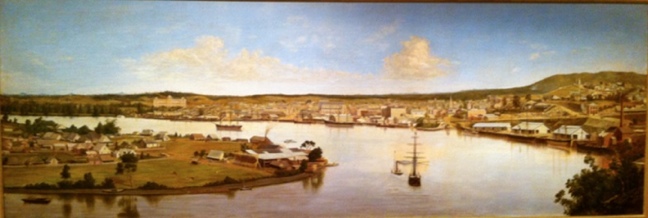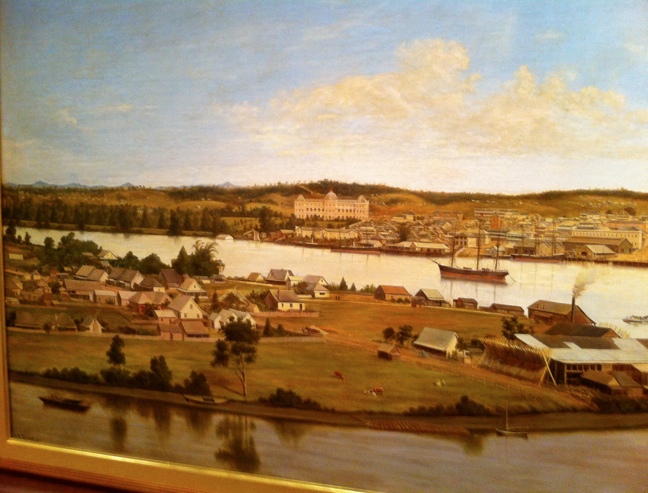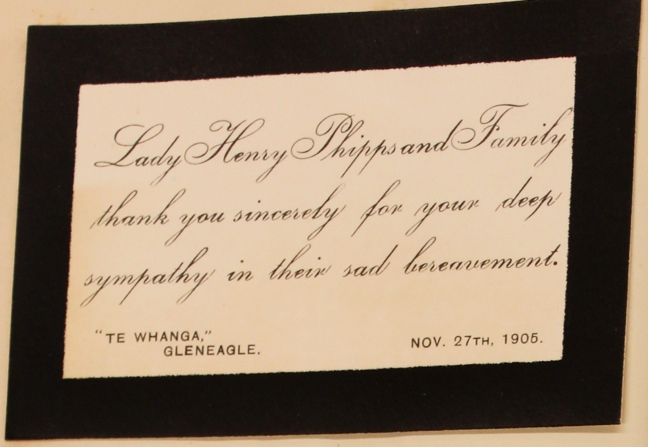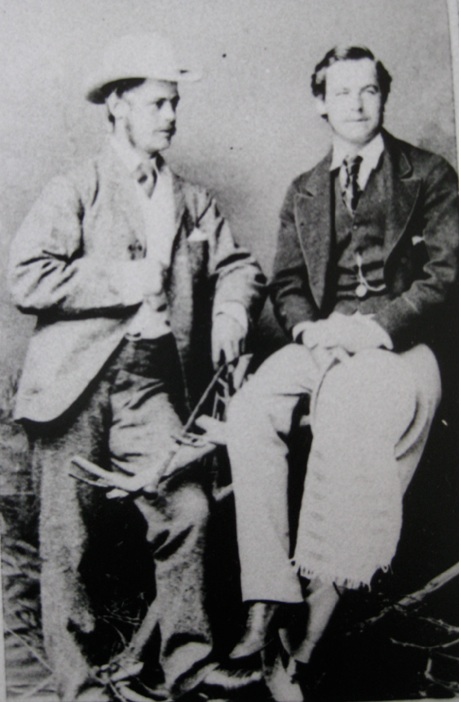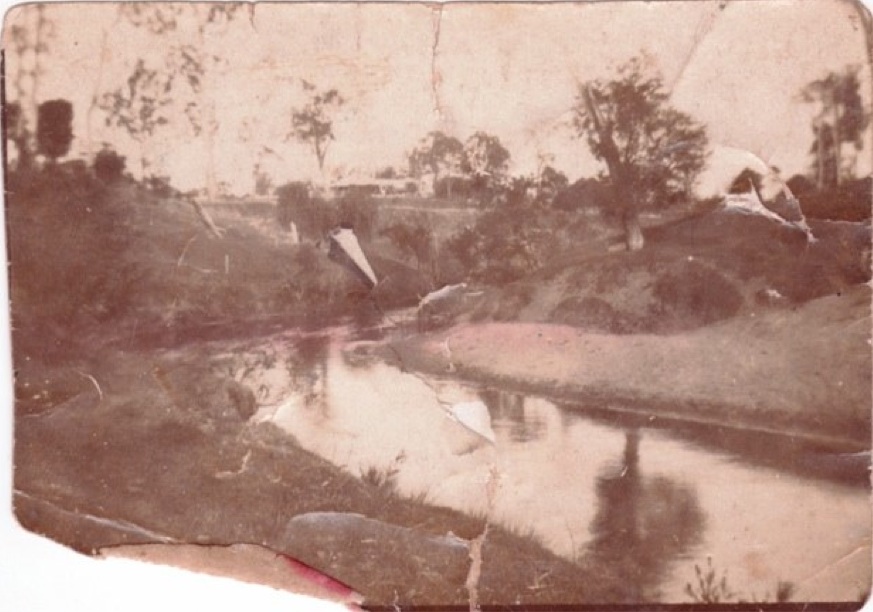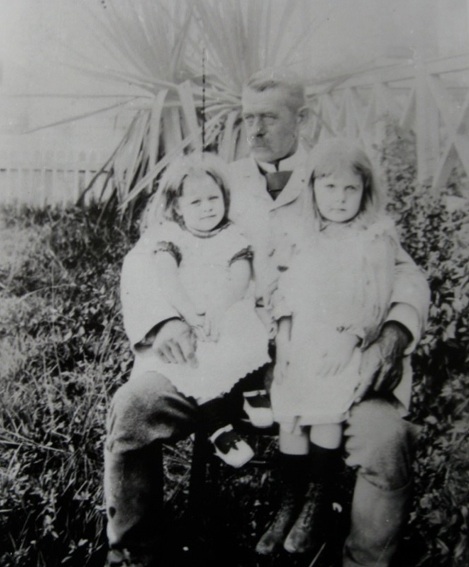Norma Caroline Georgina Leith-Hay and Henry George Russell Phipps
May 3, 2014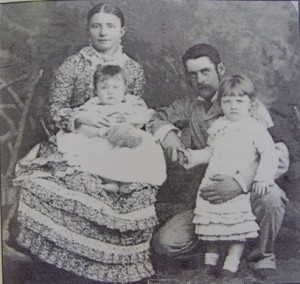 Many Scot’s family or clan websites most often focus on the details of only those with illustrious pasts and particularly the heads of the families down the line. Primarily, the details are only fleeting, and follow the achievements of the male lines, with the lives of females confined to mere footnotes, which mention marriage and the number of offspring produced.
Many Scot’s family or clan websites most often focus on the details of only those with illustrious pasts and particularly the heads of the families down the line. Primarily, the details are only fleeting, and follow the achievements of the male lines, with the lives of females confined to mere footnotes, which mention marriage and the number of offspring produced.
As this site was intended as an archive on the history of this family, the material available provides for an in depth look at the various women, who also carried the name through birth or marriage. Often these women had fascinating lives of their own, and were perhaps confined by the times they lived in, to settling into the traditional family roles customary to females.
Norma Leith-Hay, the elder sister of Charles Edward Norman Leith-Hay, provides one such subject to look at, and although very little record of her own hand is available, the papers of the time provide glimpses into her life. A history of her time, still incomplete and with many gaps, can be read below. Her life from 1857, to her passing in Yeppoon, QLD, in 1935, encompasses her birth in then colonial New South Wales, to her youth in the new colony of Queensland in Brisbane, Ipswich and Rockhampton. Detailed information on her marriage at 21 years of age at St Paul’s in Ipswich QLD, to her later short relocation to the United Kingdom, and final return to Queensland at Sandgate, and later Beaudesert and Gleneagle at her residence, Te Whanga, which for 40 years served as her home, and even after her husband’s demise in sad circumstances in 1905 is available.
The below images may provide some insight from the past.
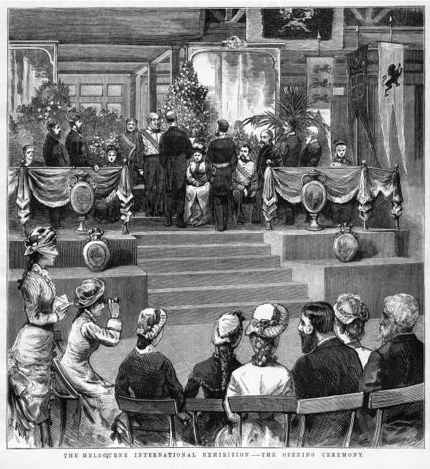 I have added J.H Clarke’s painting from 1880 at the QLD Gallery of the developing colony for the world exhibition in Melbourne, which Norma and her husband attended. (see image to right of her father-in-law at the opening in Melbourne)
I have added J.H Clarke’s painting from 1880 at the QLD Gallery of the developing colony for the world exhibition in Melbourne, which Norma and her husband attended. (see image to right of her father-in-law at the opening in Melbourne)
The image of Brisbane below, not only shows the past at the time the family lived here, but also one of the last views of the home of their youth for Norma’s siblings and father who never returned to Queensland and Brisbane after they left in 1880-81. On departing Brisbane, the sights along the river would have been very much like in the picture, before steaming off into Moreton Bay and the passage north through the Coral Sea ports and then via Batavia and through the Suez Canal towards Europe.
The QLD Gallery outlines Clarke’s grand picture in the rhetoric of the time as a record of the progress of civilisation in the colonial capital since European settlement 56 years earlier. Further quoting from the plaque this was evident in the wharves, warehouses, factories, shops, churches, residences, parks and above all the series of fine public buildings.
In the close up below looking at Kangaroo Point in the foreground of the City, with the Botanical Gardens on the left, the grand old Government House still extant in the present day at Garden’s Point is just visible. Old Parliament House is towards the middle and an imposing building for the time. The locations were particularly linked to her husband Henry through his father, the one time Governor of the State.
The right side of the painting further below is looking towards Spring Hill and Mt Cootha in the background.
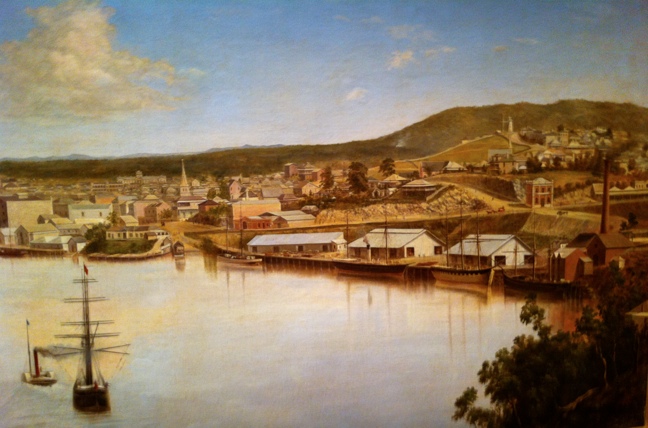
I have been unable to locate any written work from her hand, and her marriage or children’s birth documents do not include her signature before and after marriage as her husband was always the informant. The below card, however, provides a personalised thank you from her from 1905. Some further information will be placed in her section time permitting.
Norma Caroline Georgina Leith Hay (Later Lady Phipps) and Henry George Russell Phipps – family history
Norma Caroline Georgina Leith Hay was born on the 27th of April 1857 at Charlotte Street Brisbane, while the colony was still a part of New South Wales. She was the second child of James Leith Hay of Leith Hall, Aberdeenshire and Maria Catherine Gray, born in Mussellburgh, Scotland. Although some family knowledge has passed down on Norma’s life, the events after her marriage in the late 1870’s begin to afford the most detailed accounts of her life. The historical records of social gossip columns of local papers, now accessible over particularly the younger decades of her life, provide glimpses into the past that could best be characterised as a time when her own fortunes and those of her husband were at their peak. Historically, for the family, Norma’s marriage to the second surviving son of the 2nd Marquis of Normanby, also places some significance on the events. The Phipps family’s own ancestry linking to Scotland in the centuries past.
Norma’s roots were very much in Queensland, and her being a first generation Queenslander, has some bearing even on today. For the next 6 generations afterwards, much of the family born in Australia from her descent, have shared the same birth place in South East Queensland. The link to early colonial Brisbane therefore having some significance. Her father James registered her birth at the newly formed registry on the 5th of May 1857, during the week after her birth. She was baptised soon thereafter by the Reverend J Mosley. In the segment on Norma’s father James’ life, he was by appointment in Government Gazettes listed as being in Brisbane at this time. On the 2nd August 1856, the Moreton Bay Courier details him acting as a Justice of Peace (JP). A further Gazette notice 21 July 1857, lists him as a JP in Brisbane again, and this appointment continued through to 1858, as he is listed as a JP holding an inquiry over a murder at Mt. Brisbane on the 15th of June of the said year.
Therefore, it is clear that Norma never lived at, or visited Rannes in QLD or then NSW before partition, as her elder sister, Mary, born in 1855 had. This is detailed in the account of her mother, Maria, taking her to the Dawson Valley by schooner, and then by ox cart in 1856. Her birth in April 1857 in Brisbane would have, however, meant her mother had returned from Rannes already expecting her. The death of Norman Leith Hay in early 1857 had ended the Leith Hay brother’s pastoral attempts in Australia. Norma’s other uncle named Charles returned to the United Kingdom in 1858 after the younger brother Norman’s death. Norma was therefore named in memory of her uncle Norman, while her younger brother, the future Laird of Leith Hall, Charles Edward Norman, born at Ipswich QLD in 1858, was named after both his uncles who had lived in Australia. On her early childhood few details remain besides the family’s movements and records of birth at Ellenborough and Gray Street Ipswich. Her early years were spent mainly at Ipswich in the household of her grandfather Colonel Gray, (the then Police Magistrate) while a brief interlude of some years also was spent further north in Rockhampton, at Denham Street, until 1862, from which point forward the family was firmly established at Ipswich, and what appears mostly the East Street address of her grandfather.
No record has been found on what or if any education Norma may have received. More than likely her well educated mother would have been her primary influence up until her passing in 1875, from reportedly measles, at the time of her elder sister Mary’s child birth, since she had married a George A. P Hirst in 1874. This twin tragedy impacted the family greatly since both grandmother and child were lost at the same time. A family of seven children was left without their primary carer. The death of her mother at the age of 18, also obviously shifted some of the responsibility of looking after the family’s younger children onto both Mary and Norma at the time, since their father James, was at this time acting as Police Magistrate at Condamine, and later at Miles far west from Ipswich. Norma’s childhood in early colonial Queensland was one that was reasonably comfortable, even though the family was not by any means wealthy here, despite it’s gentrified background in Scotland. Moreover, in spite of the tragedies experienced by the family and her father’s career having its own ups and downs, it is clear her grandfather’s support also played a large role in the family’s upbringing in Ipswich, and would have afforded some form of security.
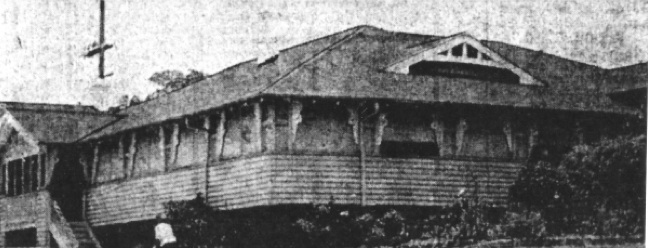
This image is of Col Gray’s East Street Ipswich home reportedly bought by James Leith Hay after his father-in-law’s passing in 1873. It is courtesy of H Hill and A Hancock and their research into the Gray family and sourced from A QLD paper of unknown date. This was the main family home at Ipswich.
Norma’s future husband, Henry George Russell Phipps, on the other hand, was born back in the old country on the 26th of January 1851 at Eaton Place Belgravia, Middlesex, to his parents, the then Earl Mulgrave and later second Marquis of Normanby, George Augustus Constantine Phipps and Laura Russell. Of Henry’s early life some extracts survive in the family archives and albums. What is notable is that for a large part of his early life, Henry and his younger brother Hervey would follow their father and mother during the various governorships that followed in the colonies. Henry’s link to South East Queensland began in 1871, when at the age of 20, he and his younger brother came with their parents to Brisbane on their father being appointed the Governor of the colony of Queensland for the period 1871-74. An early mention of him here coming from the Sydney Morning Herald, Tuesday 3 September 1872, has Henry accompanying his father on a northern tour of Queensland, onboard the steamer Kate, with the first port of call being at Gladstone.
From the records it would also appear that the younger brothers during their time in Australia and New Zealand, acted in some form of supporting role for their father. Henry had a short military background. His Sub-Lieutenancy and promotion is listed in the London Gazette March 22, 1872 prior to him arriving in Australia. It would appear that Hervey also acted as an aide-de-camp, and in an official role from 1874. The New Zealand Herald, Vol XI, Issue 4088, 19 Dec 1874, p.3 would show’s his appointment as Lieutenant of the New Zealand militia, with a commission starting from 3rd Dec of that year. This can also be seen in records on the Governor’s northern tour 1876 in New Zealand. The role continued into the Victorian Governorship, and in 1882, Hervey is still listed as A.D.C, while a Captain Le Patourel performed the duty of private secretarial role. Henry’s official role would have seemed to have ceased in Queensland.
Henry, although with his parents in New Zealand, pursued commercial interests of his own. A diary survives of one of his long 1000km journeys in Queensland during his early days here, and it is noted that he also gained experience as a drover. An article in a paper, The Clipper Hobart from 6 Jan 1894, titled “the Lord and the Squatter” outlines a story of Henry crossing the Murray River with cattle on the way from Queensland to Victoria and being called a “dinkie die good sort for a toff”, by an old squatter called Argyle during the early years, while his father was the Governor of Queensland. Henry and his brother Hervey were also frequent travellers between the ports of the east coast of Australia, from Melbourne all the way to Cooktown, as evidenced by the frequent shipping records between ports. The permanent and final link to Queensland would, however, come about from a decision made in New Zealand in the late 1870’s. While his father and mother and younger brother left New Zealand for Victoria in 1878, Henry’s decision was to come back to Queensland, and most likely through his father’s help, he was able to obtain property in the Warrego in Queensland and on the Logan, near Beaudesert, south of Brisbane.
The major event reported in late 1878 on Norma’s and Henry’s life is the article repeated in many of the papers of the time titled ‘Wedding in Queensland High life.’ Shortly after their engagement a wedding was held on the 18th of November 1878 at St Paul’s Ipswich, and the above link will show the images of the church from the time, as well as the wedding description, where the whole remainder of the Leith-Hay family was still together in Australia, prior to the younger family members all departing the country, and for all but two of the family for the final time. It is notably one of the last mentions of Norma’s brothers, father and sisters in Australia. Charles departed soon through Sydney and Melbourne to Europe in around 1880 and the youngest siblings followed in 1881.
Lords Hervey and Henry Phipps from the family album
Henry’s commercial efforts were also to shift from the west of Queensland, closer to his family living in Beaudesert, at the Hollow Station on the Logan River. The Hollow reportedly had the finest dam on the Logan, which Henry had constructed at high cost, and also financially became a loss during the floods of 1887, when it was washed away. Henry had also held a large parcel of land in the Warrego district, comprising some 484 square miles or 310000 acres at his Pinkilla Station, and this included the blocks Pinkilla, Prince, Sharkey, Kasir, Lumpy, Lumpy No.2, Moscow and Russia together with 2000 head of cattle and 50 horses, which he appears to have sold to Messrs Clark and Rocke at a Satisfactory figure according to the Brisbane courier’s Fri 30 Nov 1883, which lists the Queensland Mercantile and Agency Company’s report for 29th November of the year.
The Phipps family in Australia from Henry and Norma also began to grow, and the first child Laura Elizabeth Minnie Phipps, (the older child in the above photo at the top left) was born in 1879, and was soon followed by her sister Katherine Georgina Constance Phipps born on, 2 October 1881, at the Hollow, Logan (see photo below of the Hollow Station). The two girls were followed soon by two boys. Russell Constantine Charles Phipps b. 11 March 1883 at the Hollow on the Logan River, and on the 13 August 1884, again at the Hollow, Vivian Louis Augustus Phipps, as per the births in the Queenslander and Brisbane Courier of the time. The three younger children were born in Australia as well, with Norma Cicely at Sandgate, on 12 August 1887 after a long sea journey back to Australia. The two youngest daughters were born a decade later while the family resided at Te Whanga, Gleneagle at Beaudesert between 1895 and 1898. Te Whanga was a Maori word for harbour which Henry picked up on his New Zealand tour.
This image of the Hollow on the Logan from the time
The first years of the newly married couple were the most frequently reported on the growing family. Henry was described as a man who was able to make things happen during his earlier years in Queensland. Another description names Henry as Logan’s premier sportsman, and no doubt this image would have stuck for some time, and of course had some air of truth. Although it was most likely due to his privileged upbringing, and connections, which had granted him the time and resources to pursue such hobbies that fostered this pasttime. Henry was a founding member of the Logan and Albert Jockey Club, and well as the similarly named Logan and Albert Gun club. His name appears in trap shooting events from Ipswich to his home area, and he appears to have been somewhat decent in this pursuit. The Queensland Figaro, Sat 6th Dec 1884 p.7, in the Trigger a report of the competitions described him winning four out of five sweeps and dividing one.
The family’s social position at this time was also one of some standing. Events on the local Brisbane or Melbourne social calendar, to more every day happenings, would often be reported on the newly married couple. A Town Hall Benefit concert described in The Argus Melbourne, and reported on the 2nd June 1879, shows the couple with Henry’s brother, Hervey and their father in Melbourne. It was no doubt simply due to his connection to his father, the Governor, that made Henry some subject of interest for the press.
Frequent shipping and travel notices or local matters around the Beaudesert region, ranging from commercial matters or every day notices such as Henry’s effort’s to open a school at Bromelton and other daily matters, give some further regular insight into the times. The family’s visit to Melbourne during the 1880-81 World Exhibition in January 1881, as well as Henry’s sister’s, the Countess of Ellesmere’s visit, at the same time with her husband received some coverage in both Melbourne and Brisbane, and was another event of some surviving note. His sister and brother-in-law both visiting the family at the Hollow Station in late March to early April as reported by the Brisbane Courier 26th March 1881 with side trips to other locals such as Mr William Tutun Walker at Townsvale and a day at the races at Beaudesert being described as the activities. Henry was also somewhat of a show pony in an eccentric way. His carriage emblazoned with his Coat of Arms, pulled by white mares decorated as unicorns (a reference to his father’s Coat of Arms and Unicorn Supporter on the dexter). The Brisbane Courier, Monday 28 March 1881, describes the event in the following way on page three.
continued in much the same fashion throughout the early to mid 1880’s. Family visits to Melbourne, with life in South East Queensland, interspersed with annual yearly trips also to the higher tropics, to places such as Yeppoon or even Cooktown for holidays, or work for Henry, who also became the owner of a sugar plantation at the time. The life at the Hollow in Beaudesert was also mixed with trips to Brisbane, and social events with the local dignitaries, such as the Complimentary Ball to the Marquis of Normanby during his father’s 1882 Queensland visit, as reported in the Brisbane Courier, Mon 24th April for the year. The social calendar also included more every day events such as an All Hallows concert for June 21 1882 amongst other events. The young Phipps family’s life in Queensland continued in much the same manner until the gradual decline of Henry’s mother’s health in Victoria. The Marchioness, Laura’s illness led to the resignation of Henry’s father as Governor of Victoria and also the hasty departure in April 1884 of the Governor, the ailing Laura and their son Hervey across the the Pacific to the United States aboard the Liguria also accompanied by the family physician Mr. E.M James and henceforth onwards to their home country. The Phipps family in South East Queensland would soon make it’s own departure, as a consequence of this event. The auction list seen above for the Hollow Station in the Brisbane Courier perhaps best describing the urgency of the family’s departure and a complete sale of all the family’s estate, which went ahead on Tuesday-Wednesday 28-29 October 1884.
On what preceded the departure was a farewell and toasting for Henry and his family’s wellbeing held by some of his friends and close associates in South Brisbane at Coward’s Palace Hotel as reported in the QLD Figaro 15 Nov 1884 in some length. Shipping records soon after from Moreton Bay list the family departing Queensland aboard the Merkara, 2971 tons for London via ports with Lady Phipps, Miss Laura Phipps, Miss Catherine Phipps and Lord Henry Phipps and Master’s Russell and Vivian Phipps on the 2nd of December 1884. The next event for the family being their arrival in England and also the sad occasion of Henry’s mother’s funeral held on the 31st of January 1885 at Lythe Church near Whitby in the presence of most of the family members.
Little knowledge of the family’s activities during their time in United Kingdom and Europe between 1885 and April 1887 is known. Besides a Pony carriage mishap to Henry and Norma reported in July 1885 at Whitby in the St. James’ Budget and relayed in the Queenslander 15 Aug 1885 not much is available. The family also stayed at Sandsend in Whitby for the summer of 1885 and secured a cottage for the time as reported in the local English papers. A snippet of London news with Henry at the St George’s Club in Hannover Square in October 1886 relates some info on a dinner with Sir Anthony Musgrave, the then Governor of the colony. Henry was close to his sister and perhaps their mutual correspondence that survives may shed light on the time. A tour of Ireland in 1886 was also mentioned with his brother, the Earl and father with little further of note. What is known is that in April 1887, Henry’s brother Hervey passed in the South of France at Pau and no reason for the death is recorded in his French death certificate. At the same time Norma’s father James Leith Hay passed and reportedly at a place called St Servian next to St Malo in northern France. Henry was also a sufferer of the consumption during his latter life and it is not known from which point onwards he became ill. As no report during his earlier days in Australia mention any illness, It could well be that his health in Europe suffered at this time.
Henry’s health, however, might have been a deciding factor as mentioned. Family tradition relates a frailty on part of the Phipps males of the time to succumbing to illness. This was nevertheless not unusual for the times. William Brook Phipps passing earlier in the 1880‘s and Hervey dying in April 1887 left the Phipps line also short on male’s in that generation. Henry being the only one with son’s at the time as his elder brother, the Earl did not have children until another 20 years. His uncle’s Charles Beaumont Phipps’ family also continuing and later in Canada from their father’s generation. Europe had also succumbed to a flu epidemic between 1883-87 and the winter’s during these years were historically described as fiercely cold due to the effects of the Krakatoa volcano eruption in August 1883 having global climatic impacts for the next 5 years. Hervey Phipps’ and Norma’s father James’ passing at around the same time in April 1887 in France might therefore somehow be related to illness and perhaps played a part in the family’s return. Hervey’s death certificate from Pau in does not provide a cause, but James passed in St Malo from illness and old age after a arduous life in Australia.
It is entirely plausible from what followed, that health reasons contributed to the move. Henry’s life after his return from Europe was plagued by the ills of consumption. In the 1890’s records exist of him obtaining treatment in Sydney for his ailment. Tuberculosis was so often very fatal and a warmer climate definitely helped in obtaining relief and it may well be that his return was precipitated because of this. The family living in Sandgate Brisbane after their arrival in July 1887 might provide a further clue as to his condition. Norma’s and Henry’s third daughter, Norma Cicely Gray Phipps being born on August 12, 1887 at Sandgate only a few weeks after the long return sea voyage further showing their residence there. No doubt a seaside climate would have aided any recovery. The Phipps family appears to have kept Sandgate as a residence for some time on it’s return. Upon Henry’s father’s final visit to Brisbane in early 1888, a Brisbane Courier article Wednesday April 4th relates the story of Henry’s father and Sir Anthony Musgrave visiting the Sandgate Pier aboard the Government steam yatch Lucinda, where they picked up and met Henry and Norma for lunch before the whole party’s return to Brisbane. Together with a few other events at this time such as the April opening of the Queensland Opera in Queen Street, this visit also proved to be the final meeting of father and son.
No doubt other reasons existed for the Marquis’ presence here at the time besides meeting his younger son and his family. The attempt to gain a new governorship such as the rumoured South Australian or Western Australian vacancies coming up, which eventually nevertheless fell through after being reported in the press. Perhaps these played a part and the attempt to help his younger son’s and family’s future which possibly weighed on his mind in his older age. The fortunes of Henry and Norma were also to take a change past this point. The local papers short financial report on the 15th of March 1889 highlighting the change of circumstances ahead. A bankrupt Lord being the title and adjucation of insolvency the result. The asset price collapse on the late 1880’s and ensuing banking crises of the early 1890’s no doubt possibly also having an effect. The idea of working and in a commercial capacity may have been a foreign concept to one who colloquially was raised with a silver spoon. Henry, however, also attempted to make a living under these circumstances and during the middle of the year accepted and appointment under the Firm Finney Isles and Co as reported in the papers. A life threatening accident also followed on Stanley Street South Brisbane on January 29 1890 as reported in the local papers and a scalp wound as well as internal injuries with Henry’s condition being described as critical in the news.
The family’s final move back to the Logan region near Beaudesert occured in 1891 after some 4 years of the family’s return and relative quiet life. The above image shows Te Whanga and the river bend at Gleneagle and the house in the background. The Queenslander 12 Sep 1891 reports on Henry renting Te Whanga and describing the land at one time being owned by him. He had purchased it with the idea of erecting stables and keeping some horses there as a stage when driving from the Hollow to Brisbane, before the railway was made. Now his family would reside there. The development of this project can be seen in the Queenslander Saturday 19 November 1892 which rapidly describes the transformation of Te Whanga, where it would soon be in a perfect order as an English domain. For the coming years, the reports of the family entertaining on the property and Henry and Norma performing duets for their guest fills the spaces on social notices on the family. (It is intended this history is to be continued on to her husband’s passing and the Newspaper source on this as well as her own passing in Yeppoon in 1935)
